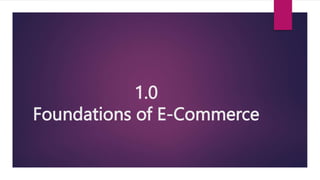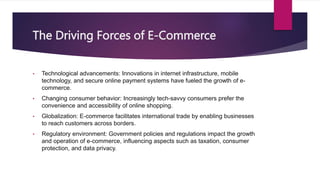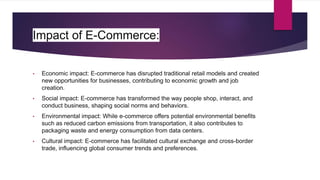Fundamentals of E-commerce - E-commerce
- 2. Definitions and Content of the Field E-commerce, short for electronic commerce, refers to the buying and selling of goods and services over the internet. It encompasses a wide range of activities, including online retail (e-tail), electronic payments, online auctions, internet banking, online ticketing, and more. The field also includes related activities such as online marketing, supply chain management, and electronic data interchange (EDI).
- 3. Benefits • Increased reach and accessibility: E-commerce allows businesses to reach customers globally, breaking geographical barriers. • Cost-effectiveness: Online businesses often have lower overhead costs compared to traditional brick-and-mortar stores. • Convenience: Customers can shop from anywhere at any time, leading to enhanced customer satisfaction. • Personalization: E-commerce platforms can leverage data analytics to offer personalized recommendations and tailored shopping experiences.
- 4. Limitations • Security concerns: E-commerce transactions are susceptible to cyber threats such as hacking, data breaches, and identity theft. • Lack of tangibility: Customers cannot physically inspect products before purchase, leading to potential dissatisfaction with product quality or appearance. • Technical issues: Glitches, website crashes, and slow loading times can frustrate users and lead to lost sales. • Dependency on internet access: E-commerce relies heavily on internet connectivity, which may be limited in some regions or for certain demographics.
- 5. The Driving Forces of E-Commerce • Technological advancements: Innovations in internet infrastructure, mobile technology, and secure online payment systems have fueled the growth of e- commerce. • Changing consumer behavior: Increasingly tech-savvy consumers prefer the convenience and accessibility of online shopping. • Globalization: E-commerce facilitates international trade by enabling businesses to reach customers across borders. • Regulatory environment: Government policies and regulations impact the growth and operation of e-commerce, influencing aspects such as taxation, consumer protection, and data privacy.
- 6. Impact of E-Commerce: • Economic impact: E-commerce has disrupted traditional retail models and created new opportunities for businesses, contributing to economic growth and job creation. • Social impact: E-commerce has transformed the way people shop, interact, and conduct business, shaping social norms and behaviors. • Environmental impact: While e-commerce offers potential environmental benefits such as reduced carbon emissions from transportation, it also contributes to packaging waste and energy consumption from data centers. • Cultural impact: E-commerce has facilitated cultural exchange and cross-border trade, influencing global consumer trends and preferences.





